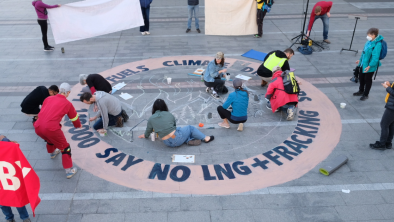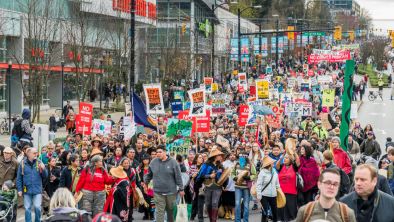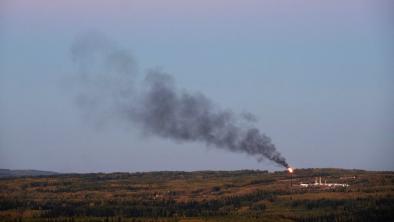Fears of Cost Overruns, Flooding of Peace Valley Loom on Eve of Site C Dam Report
DeSmog Canada

Opponents of the proposed Site C dam are hoping a report from the Canadian Environmental Assessment Agency panel, to be released Thursday, will emphasize potential environmental damage from the massive dam and persuade the federal and provincial governments that the project should be scrapped.
The report from the Joint Review Panel into BC Hydro’s $8-billion plan to build a dam that would flood 83 kilometres of the Peace River, putting 14,000 hectares of farmland under water, was submitted May 1 to federal Environment Minister Leona Aglukkaq and the B.C. Environmental Assessment Office, but there was no obligation to release it to the public for 45 days.
“The fact that they decided to share it just after they got it themselves is a little bit surprising, but we are feeling optimistic and hoping for the best,” said Andrea Morison of the Peace Valley Environment Association.
The panel’s recommendations, put together after 26 days of hearings, are not binding on government, but are likely to outline issues and possible solutions as well as indicating whether some environmental problems are insurmountable.
“There’s nothing binding, but I think it holds a considerable amount of weight,” Morison said.
The report will be posted on the Canadian Environmental Assessment Agency’s website Thursday. The provincial and federal governments must make their own decisions within 174 days, or six months, of the report being issued.
“The province has been very clear from the get-go that they support Site C,” said Joe Foy, Wilderness Committee’s national campaign director.
However, if the federal government decides it can’t support the project, Site C would probably die, Foy speculated.
“It’s clearly a matter that would require the federal OK. There are massive impacts that are clearly in the federal arena,” he said.
In February, the federal government rejected the New Prosperity Mine near Williams Lake, despite it having provincial support, after concluding the mine would have environmental effects that could not be mitigated.
There is speculation that even within the B.C. Liberal party there are doubts about whether Site C is necessary, although Premier Christy Clark has made it clear she is a supporter and much of the last election campaign was built on proceeding with Site C as a key building block of developing a liquefied natural gas (LNG) industry.
However, Energy and Mines Minister Bill Bennett has consistently been more cautious and said shortly after the election, when revelations were made about BC Hydro’s new capital costs and construction cost overruns, that he wanted to make sure that government would not be facing cost overruns with Site C. Because BC Hydro is a Crown corporation, cost overruns would be borne by taxpayers.
“Bill Bennett frequently seems to be keeping the door open on Site C,” Foy said.
“He told us in January that he had a team of researchers looking at alternatives to Site C.”
Bennett also recently told the Globe and Mail that there could be another level of screening on Site C costs. Government previously decided to circumvent the Crown corporation’s regulator, the B.C. Utilities Commission, which would have looked at financial issues. The environmental review is not expected to look closely at cost, necessity or practicality.
Questions have also been raised about whether LNG plants would find hydro power too expensive and would be more likely to use gas to feed their massive electricity needs.
Paul Kariya, executive director of Clean Energy BC — an industry trade association that represents independent power producers, including gas generators — recently told DeSmog Canada that the major LNG companies are looking at powering their plants via natural gas.
“Times have changed. We’ve been through an era of building big dams,” Kariya said. “When you build a dam, you get this one massive lump of power and that’s not the way that energy is planned for anymore.”
Kariya says independent power producers offer a more incremental approach to meeting demand.
However, even with a report from the World Convention on Dams — which says that projects routinely come in at 50 per cent more than estimated — and mounting evidence that the power produced by Site C is not needed and is likely to be sold at a loss, it is doubtful that the province will back down, said retired federal economist Erik Andersen.
“They are addicted to big photo-op projects,” he said.
“Over the course of the past four decades, the need for a Site C generation facility has been part of the larger and exaggerated demand narrative that BC Hydro has been telling.”
Site C — which gets its moniker from being the third dam proposed for the Peace River — has been on the books since the ’70s. It was first turned down by the independent B.C. Utilities Commission in the early '80s, which said BC Hydro hadn't demonstrated that the power was needed or that the dam was preferable to all other sources of power. In the ’90s, BC Hydro suspended the project again because the need for power was still considered insufficient.
Morison is hoping that, with release of the panel’s report, Site C will start catching the attention of people throughout the province, especially if they learn their Hydro bills are likely to rise beyond the 28 per cent increase already expected over the next five years.
“They need to realize that this is going to cost them,” she said.
Photo: The Peace River Valley near the Halfway River. Tuchodi via Flickr.


